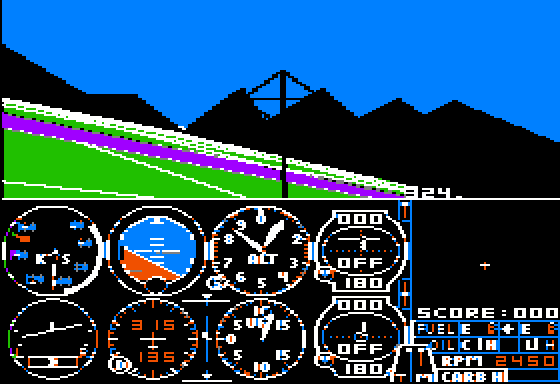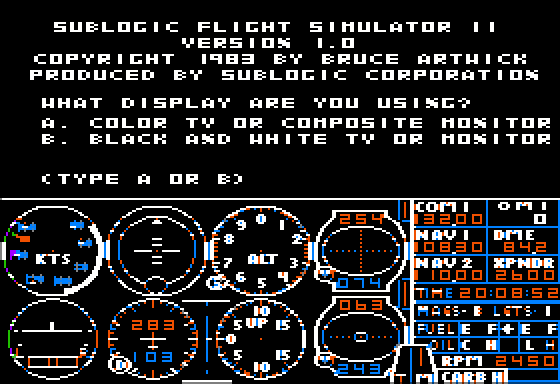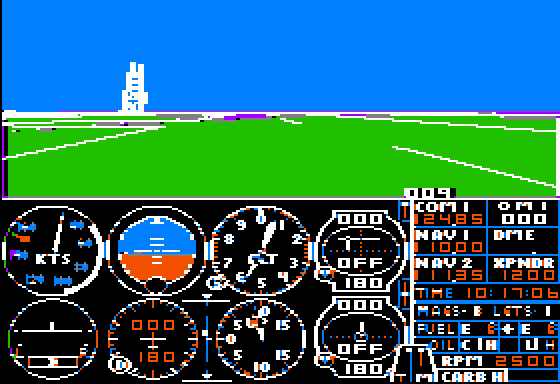
Database
 1st November 1984
1st November 1984
Published in Apple User Volume 4 Number 11
Flight Simulator II
The Flight Simulator II package, version 1.0 for the Apple II+ or IIe with a minimum of 48K and one disc drive comes complete with a Pilot's Handbook, flight reference card and four area charts covering New York, Los Angeles, Chicago and Seattle.
The author Bruce Artwick - himself a pilot - has made substantial improvements over his first simulator A2-FSI. The flying environment has been increased from a few square miles to an astounding 10,000 by 10,000 square miles, with a resolution better than 2.5 inches.
A composite colour monitor is recommended although a monochrome monitor can be used. This option is chosen from the start-up menu. From the second menu you can choose an automatic demo or the real thing.

The display is split in two horizontally. The bottom half is for the standardised instrument cluster. Left of centre is the flight instrumentation consisting of speed, altitude, gyro compass, artificial indicators, plus rudder and elevator indicators.
Top right are the navigational instruments while the bottom right is for the enging instrumentation and controls.
All of these are fully operational, being controlled from the keyboard, although a joystick may be used for directional control.

Above this cluster of instruments is the 3D out of the window view. To give all round visibility there are a total of eight views available plus the downward-pointing radar, useful for finding your way round the various airports.
The display uses colour to distinguish between land (green), sea (purple, perhaps it's my RGB monitor), city areas (black), sky and clouds (blue and white).
By far the best way to learn the layout of the cockpit is to boot the disc and with the aid of the manual, go through all the flight controls to see what effect they have on the instrumentation. As long as you don't touch the throttle nothing drastic will happen.

To get you in the air quickly, there is an easy mode. When in this, the engine is started automatically and the rudder is connected to the aileron making the plane relatively easy to turn.
An editor is provided (similar to Night Mission Pinball) which allows you to alter any of the flight and weather parameters - yes weather.
There are three wind zones (vertically) that may be set with height, speed and direction plus two cloud banks that can be varied.

It's quite uncanny when climbing through a cloud bank to break through the top into a scene of blue skies with the white of the clouds visible below.
The season of the year may be chosen. This affects the times at which night turns to dawn, dawn to day, day to duck and duck to night. Turbulence (64K only) can also be created.
The parameter values you see on the edit pages are the current flight parameters whose values change as you fly.
A user mode library can be created to store a complete set of current flight parameters for recall at a later time. There are 25 modes available. Ten preset modes and fifteen user-definable modes. More than seventy airports are included, each recognisable from the air with their runways, taxi ways and parking areas by means of a vertically orientated radar fitted in the plane.
Each of the airports is equipped with its own set of frequencies for use with the communications radio (receive only) and two navigation radios. Major airports also make use of ILS (instrument landing systems).
The most frequently used instrument for navigation is the VOR (very high frequency range). These are radio stations that transmit an omni-directional synchronisation signal followed by a circular sweeping directional signal.
Three instruments on the plane are used in conjunction with the VOR. One of the nav-radios is tuned to the VOR frequency required. When in range, the DME (distance measuring equipment) gives the range from the beacon in nautical miles. To obtain the bearing of the beacon, the VOR indicator is tuned so that the pointer is centred and the bearing is then read from the instrument.
It is possible to pinpoint your exact position on one of the area charts by tuning in both nav-radios to different beacons and triangularing between the two. If all this sounds complicated, it is, but it is fully covered in the Pilot's Handbook.
When you are reasonably proficient at handling the plane, you can test your skills by playing the World War I Ace game. It is very similar to the game provided with the A2-FSI, in that you still cannot see the enemy except on radar, which makes it very difficult to shoot him down.
Your plane is equipped with five bombs, with which you bomb the enemy fuel dumps and factories. Scores are one for a plane shot down, 10 for destroying a fuel depot and 20 points for bombing a factory.
Nothing I have seen so far indicates that there are any bugs in the system, but the database is so large that it would take months of navigating around all the airports and then landing and taking off in every direction. If anyone has used the simulator and found any bugs, perhaps they would let us know.
There are a few minor differences between the 48K and 64K versions, both on the same disc. These include improved needle graphics, impossible to dim the panel at night on the 48K version, additional seasonal effects with 64K, course plotting on the 64K version and improved engine simulation on the 64K.
Sub-Logic have promised more improvements in later versions. These include a better artificial horizon, war game bullet tracers and visible enemy aircraft.
Also a second manual entitled Flight Physics and Aircraft Control with an introduction to aerobatics should be sent to registered users. Scenery discs will also become available, which will fill out the wide open spaces on the area charts.
At about £32, it's not cheap but if you're interested in flight simulators it's worth every penny.



